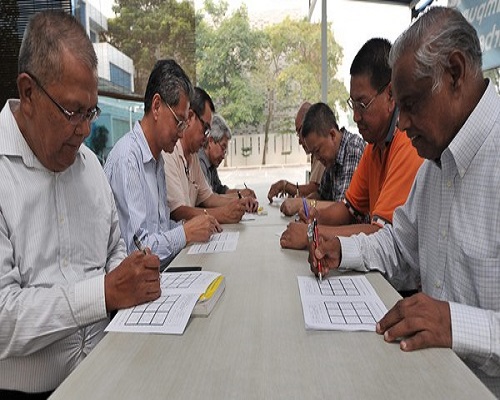Introduction
Swallowing difficulties (dysphagia) may be experienced by individuals who have suffered stroke, traumatic brain injury, neurodegenerative diseases such as Parkinson’s, or any problem involving the swallowing structure for example tongue or nasopharynx cancer. These difficulties may cause dehydration, increased secretion, and aspiration. Aspiration is a situation there is food or liquid entering the lungs. Then may lead to pneumonia and even death.
For individuals whose present with aspiration, the use of a feeding tube would be necessary. If your Speech-Language Therapist recommends oral feeding, here are seven components strategies to ensure your safety feeding.
-
Mental and physical state
-
Setting
-
Positioning
-
Food selection
-
Mealtimes strategies
-
After meal strategies
-
Between meals strategies
Mental and Physical State
-
Do not eat if sleepy, confused, or tense.
-
Do not eat if unusually weak or out of breath.
Setting
-
Reduce electronic distractions such as turn off television (TV), radio, or cell phone.
-
Close the doors to reduce outside distractions. It may cause by traffic’s noise or factory’s noise.
-
Do not overdo conversation or promote laughter while eating.
Positioning
| DO’S | DON’TS |
|
Sit upright and ensure neck support. |
Do not lean or tilt back too far when eating or drinking. |
|
Sit straight with feet flat on the ground . |
Do not feed while standing up. Looking up is potentially dangerous for people with swallowing difficulties. |
|
Sit opposite and at eye level to the person being fed. |
Do not feed someone from the side unless the Speech-Language Therapist suggested you to. |
|
Keep your head straight or bend down when drinking. |
Do not tilt your head too far back when drinking. |
Food Selection and Preparation
-
Avoid foods that are difficult to swallow such as crusty bread, popcorn, raw vegetables, nuts, and peanut butter. This type of food needs an efficient chewing skill. A person with poor chewing skill will found difficulty to swallow these foods. Then having a risk to aspirate.
-
Look out for foods with mixed consistency. The food contains more than one texture such as solid and fluid mixed together. For example cereal with milk, or rice with soup.
-
Be careful with foods that melt. For example ice-cream. It is because a person may be safe with solid or semi-solid texture but not fluid texture yet. So, have a check first to ensure the person safe for both textures.
-
Thicken liquids by using thickening agent. You can make liquids thick as honey, nectar or pudding as directed by your Speech-Language Therapist. Then the thicken liquids safe to be swallowed.
Mealtime Strategies
-
Take enough time to finish your meal.
-
Eat a small amount at a time. For example, only take food half of tablespoon for each feed. Then continue doing this strategy till you finish your meal.
-
Chew thoroughly. For solid food such as rice or biscuit, you need more frequent chew compare to semi-solid food such as blended porridge or pudding.
-
Finish each swallow before reloading spoon or fork with food or liquid.
-
After swallow, check mouth for leftover food or pill. If there is leftover food or pill, clear them by using tongue, finger, or mechanical suction. Besides that, you can alternate solids and liquids to clear the leftover.
-
Note cough, choke or gag of food or liquid, tearing, runny nose, or nasal regurgitation. Those are the sign and symptom of swallowing difficulties. If there is any sign and symptom noted, please see your Speech-Language Therapist for swallowing assessment and consultation.
After Meals Strategies
-
Do not lie down after eating but do other physical activity such as walking, gardening or cleaning house.
-
Clean teeth, gums, and dentures several times per day. It is important to have good oral hygiene. Then having safe oral feeding.
-
Swab lips, tongue, and cheeks to moisturize and lubricate the mouth.
Between Meals Strategies
-
Watch for cough, chest pain, voice change, fever, or respiratory difficulty such as rapid breathing and wheezing. If there is any sign and symptom noted, please see your Speech-Language Therapist for swallowing assessment and consultation as soon as possible.
-
Carry out recommended swallowing-related exercises that suggested by your Speech-Language Therapist.
-
Work on overall fitness, muscle strength, balance, and posture of your body. This will help improving your swallowing function.
-
Keep mind and body active with reading, doing word puzzles and Sudoku, and other activities.
 |
| Source: www.kosmo.com.my |
-
At bedtime, elevate your head to 30 degrees to help prevent aspiration or reflux.
Conclusion
It is important that you refer to your Speech-Language Therapist, doctor, or dietitian if you have any doubt or enquiries with regards to your swallowing difficulties. You should also stick to your speech therapy appointment to ensure that swallowing strategies, exercises or food and drink consistencies are updated to your current swallowing ability.
Reference
-
Feeding a Patient with Dysphagia; retrieved September 18, 2012 from www.hnehealth.nsw.gov.au
-
Sayadi, R. & Herskowitz, J. (2010). SWALLOW SAFELY: How Swallowing Problems Threaten the Elderly and Others. A Caregiver’s Guide to Recognition, Treatment, and Prevention. Inside/Outside Press, US.
| Last Review | : | 28 August 2020 |
| Writer | : | Siti Suhana bt. Mohd Khalid |
| Accreditor | : | Nor Fadhilah bt. Ab Halim |
| Reviewer | : | Nadwah bt. Onwi |







